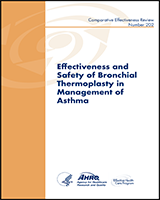Effectiveness and Safety of Bronchial Thermoplasty in Management of Asthma
Comparative Effectiveness Reviews, No. 202
Authors
Investigators: Kristen E D’Anci, PhD,,* Marcus P Lynch, PhD,,* Brian F Leas, MS, MA, Andrea J Apter, MD, MSc, Tyra Bryant-Stephens, MD, Janice L Kaczmarek, MS, Craig A Umscheid, MD, MSCE, and Karen Schoelles, MD, SM.Affiliations
Structured Abstract
Objective:
This review assesses the effectiveness and safety of bronchial thermoplasty (BT) in adults with asthma.
Data sources:
We systematically searched the gray literature and five bibliographic databases, MEDLINE®, Embase®, PubMed®, CINAHL®, and the Cochrane Library, through April 20, 2017.
Review methods:
Eligible studies included systematic reviews, meta-analyses, randomized controlled trials (RCTs), and nonrandomized interventional studies with concurrent controls. Case reports and series were also considered for describing adverse events. Studies were evaluated for risk of bias using the Cochrane Risk of Bias instrument, and the evidence base was assessed using the methods guidance established by the Evidence-based Practice Center program.
Results:
Fifteen studies, including three RCTs with 5-year single-arm followup in BT-treated patients (n=432 for the RCTs), examined the impact of BT in addition to standard care (continued medical management) on patients with asthma. BT and standard care improved asthma control (defined by the Asthma Control Questionnaire [ACQ] change from baseline to 12 months) and Asthma Quality of Life Questionnaire (AQLQ) scores more than standard care alone to a degree that was statistically significant but not clinically important (low strength of evidence [SOE]). However, BT and standard care, compared with a sham bronchoscopic procedure and standard care, did not improve asthma control (defined as ACQ change from baseline to 12 months), hospitalizations for respiratory symptoms, use of rescue medications, pulmonary physiology measures, or AQLQ scores (in the intention-to-treat analysis) (low SOE). In the same sham-controlled trial, BT reduced severe exacerbations after the 12-week treatment period to a statistically but not clinically important degree (low SOE), and patients undergoing BT had fewer emergency department visits than patients who had the sham bronchoscopic procedure (moderate SOE). In the RCTs comparing BT and standard care to standard care alone, evidence was insufficient to assess if BT reduced rates of severe exacerbations. Common adverse events following BT during the 12-week treatment period in the RCTs included bronchial irritation, chest discomfort, cough, discolored sputum, dyspnea, night awakenings, and wheezing. Hospitalizations were more common in patients undergoing BT than with either standard care alone or sham bronchoscopy during the 12-week treatment period, as were upper respiratory tract infections, wheezing, dyspnea, lower respiratory tract infections, anxiety, and segmental atelectasis, but the events were too infrequent to achieve statistical significance. Severe adverse events (including post-procedure segmental atelectasis due to mucus plugging, hemoptysis, chest infections requiring hospitalization, and bronchial artery pseudoaneurysm) were also reported in six case reports and two small case series. Following the 12-week treatment period, rates of respiratory-related hospitalizations were not significantly different between groups for up to 5 years of followup. No deaths were attributed to BT.
Conclusions:
While asthma control and quality of life measures modestly improved in patients undergoing BT compared to medical management alone in two controlled but nonblinded studies, these measures did not improve in the sham-controlled study. The sham-controlled, blinded study found modest improvements in severe exacerbations and significantly fewer emergency department visits following BT compared to the sham bronchoscopic procedure, but serious adverse events and post-procedure hospitalizations were more common during the 12-week treatment period in patients undergoing BT than in patients undergoing sham treatment. The available body of literature on BT is small and uncertainty remains about appropriate patient selection criteria and the effects of the treatment beyond 5 years.
Suggested citation:
D’Anci KE, Lynch MP, Leas BF, Apter AJ, Bryant-Stephens T, Kaczmarek JL, Umscheid CA, Schoelles K. Effectiveness and Safety of Bronchial Thermoplasty in Management of Asthma. Comparative Effectiveness Review No. 202. (Prepared by the ECRI Institute–Penn Medicine Evidence-based Practice Center under Contract No. 290-2015-00005-I.) AHRQ Publication No. 18-EHC003-EF. Rockville, MD: Agency for Healthcare Research and Quality; December 2017. www.effectivehealthcare.ahrq.gov/reports/final.cfm. DOI: https://doi.org/10.23970/AHRQEPCCER202.
This report is based on research conducted by the ECRI Institute–Penn Medicine Evidence-based Practice Center (EPC) under contract to the Agency for Healthcare Research and Quality (AHRQ), Rockville, MD (Contract No. 290-2015-00005-I). The National Institutes of Health (NIH) National Heart, Lung, and Blood Institute (NHLBI) sponsored the report. The findings and conclusions in this document are those of the authors, who are responsible for its contents; the findings and conclusions do not necessarily represent the views of AHRQ or NIH/NHLBI. Therefore, no statement in this report should be construed as an official position of AHRQ, NIH/NHLBI, or the U.S. Department of Health and Human Services.
None of the investigators have any affiliations or financial involvement that conflicts with the material presented in this report.
The information in this report is intended to help health care decisionmakers—patients and clinicians, health system leaders, and policymakers, among others—make well-informed decisions and thereby improve the quality of health care services. This report is not intended to be a substitute for the application of clinical judgment. Anyone who makes decisions concerning the provision of clinical care should consider this report in the same way as any medical reference and in conjunction with all other pertinent information (i.e., in the context of available resources and circumstances presented by individual patients).
AHRQ or U.S. Department of Health and Human Services endorsement of any derivative products that may be developed from this report, such as clinical practice guidelines, other quality-enhancement tools, or reimbursement or coverage policies, may not be stated or implied.
This report may periodically be assessed for the currency of conclusions. If an assessment is done, the resulting surveillance report describing the methodology and findings will be found on the Effective Health Care Program Web site at www.effectivehealthcare.ahrq.gov. Search on the title of the report.
- *
Dr. D’Anci and Dr. Lynch contributed equally to this report.
- 2
5600 Fishers Lane, Rockville, MD 20857; www
.ahrq.gov
